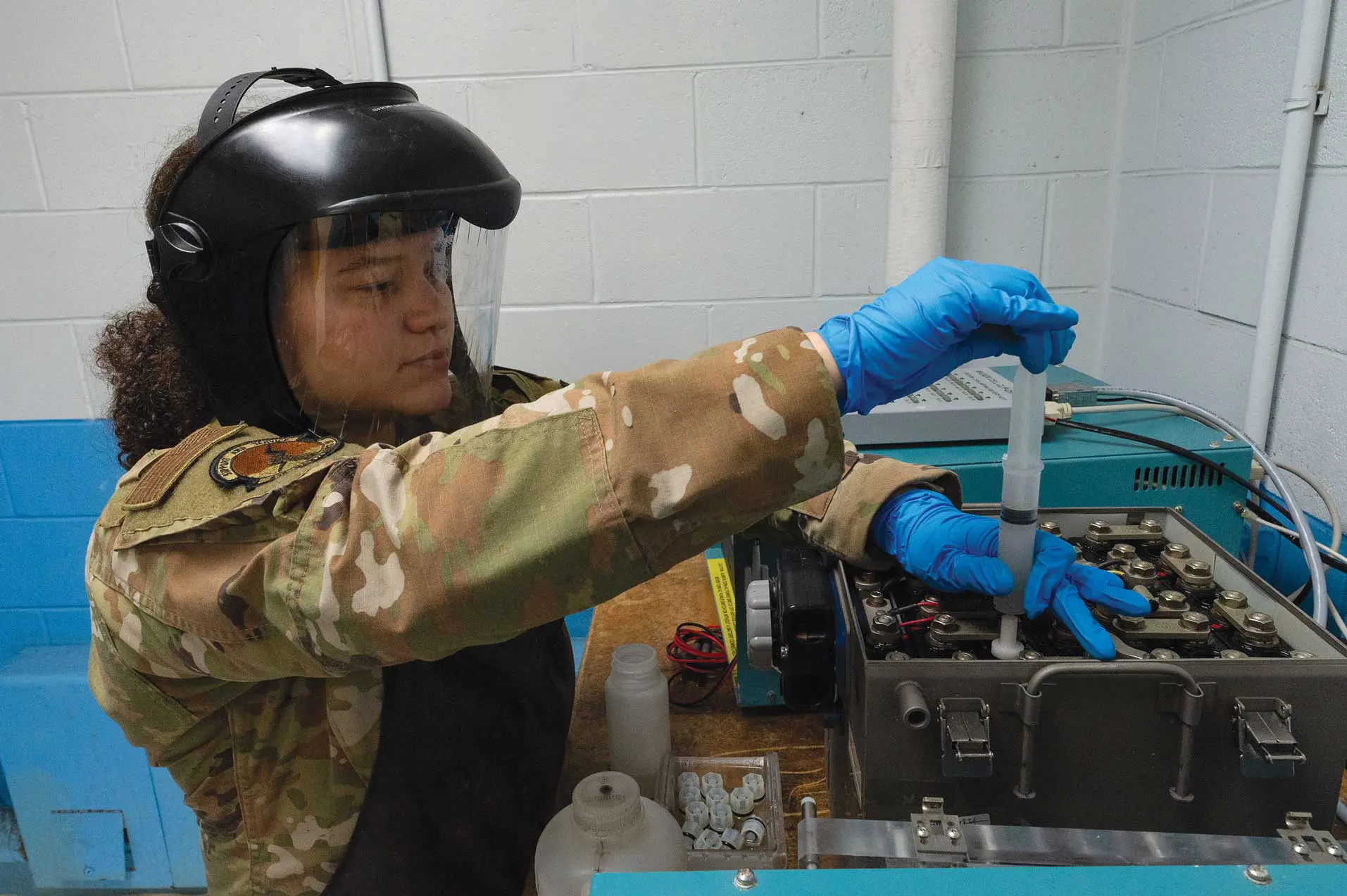Chemical Hazards Abound—In the Air and On the Ground
By Betty Nylund Barr, Staff Writer
Airmen work with numerous chemicals in their daily jobs. Various fluids necessary for the proper functioning of aircraft—jet fuel, deicing compounds, cleaning agents, fire extinguisher chemicals, lubricants, adhesives, liquid oxygen, and hydraulic fluid, for example—can be aerosolized and carried through the air as vapor. Those harmful substances can be released into the air in several ways, such as mechanical failure, seal leaks, and even during regular operational procedures, such as takeoff.[1]
Leaks may occur in engines, refueling equipment, hydraulic containers, and motors. When breathed in, they can cause serious symptoms, such as disorientation, blurred vision, impaired memory, and altered coordination.[2]Such afflictions can be disastrous for anyone working on complex machinery or piloting a plane, causing not only immediate danger but also possibly long-term health problems, including chronic neurological, cardiological, and respiratory problems from neurotoxicants, carcinogens, and other potentially toxic substances.
Beyond the harm incurred by breathing in hazardous materials, some chemicals can irritate or even burn the skin. From a rash to various degrees of burns—depending on the length of exposure—the consequences of not staying sharp and following safety protocols will make you regret not making the extra effort.
Safety is a huge concern in Air Mobility Command. Every issue of The Mobility Forum addresses some safety component pertaining to aspects of Airmen’s lives, vocations, and free-time pursuits. No one has to question whether Airmen receive adequate training in rigorous safety protocols around the aircraft and other potentially hazardous equipment with which they interact in the course of their jobs. However, thoughts or concerns may intrude, taking our focus off the job at hand:
- Should I have kept Cici home from school today, although her temperature was only 99 degrees?
- Mom would be miserable if I put her into a nursing home, but after she fell on the stairs, I have worried about her living alone.
- If the problem with my car turns out to be the electrical system, do I have enough to cover it?
We all have lives away from work, and thinking about personal issues is normal. However, losing focus while working around aircraft can result in serious injury—no matter how well you are trained and how long you have been doing your job. When you find your thoughts being pulled away from the task at hand, you need to rein them back in. You cannot do anything about that problem at this moment; it is not the time to concentrate on anything but that equipment. Your loved ones need you to go home to them intact at the end of the job.
As A1C Bryan McMahon of the 49th Aircraft Maintenance Squadron, Holloman Air Force Base, NM, reminds us, “There is one underlying mindset that keeps the number of people going home at the end of the day the same as the number who came to work in the morning, the safety mindset.”[3] McMahon says that the flightline may be one of the most dangerous places on base to work. In addition to your training, one of the most important safeguards against injury from chemicals on the job is wearing personal protective equipment (PPE).
“During fueling, wear goggles, gloves and have your T.O. [technical order] handy,” says McMahon. “For wipe downs, you will need to have goggles, naphtha gloves, long-sleeve shirt, doors open at least ten feet, and your trusty T.O.” He is pretty emphatic about that T.O.! “If you have any doubt on what the proper PPE is for a given job, just refer to the T.O. Don’t take shortcuts,” he says. “If you think you look silly wearing goggles, think how silly it would be to be blind in one eye when you could have avoided a hazard by simply wearing the correct PPE.”
Another safety tool that McMahon recommends is wingmen. Always have wingmen follow behind you and check what you have done. Having a second set of eyes is helpful in any profession, but it is a necessity when working with aircraft.
To be prepared for injuries involving chemicals associated with military aircraft, know where to find the first aid kit and the automated external defibrillator (AED). Those items should be in every workplace, so locate the ones on the aircraft and in the buildings where you work. Then, learn how to use them. If it has been a while since you had first aid and cardiopulmonary resuscitation (CPR) training, take a refresher course. You may never need to use what you learn, but if you do, you will be grateful for the time you spent brushing up.
In the end, the best way to treat chemical injuries is to prevent them. You have the training; use it. As you work, remember what you have learned about safety measures around the equipment and chemicals you use in your daily job. Be present in the moment, and know that by doing so, you will not only do your job well but also do it safely. Take all necessary precautions to be ready for a worst-case scenario.
When it comes to ensuring your safety—and, in fact, your life—how much caution is too much?
[1] Balouet, Jean Christophe, Harry Hoffman, and Chris Winder. 1999. Aviation and Exposure to Toxic Chemicals. SAE Technical Papers. https://doi.org/10.4271/1999-01-5603.
[2] Balouet, Hoffman, and Winder. Aviation and Exposure to Toxic Chemicals.
[3] McMahon, Bryan. 2007. “Flightline Safety Important to Get Aircraft Flying.” https://www.holloman.af.mil/News/Commentaries/Display/Article/319035/flightline-safety-important-to-get-aircraft-flying/.

